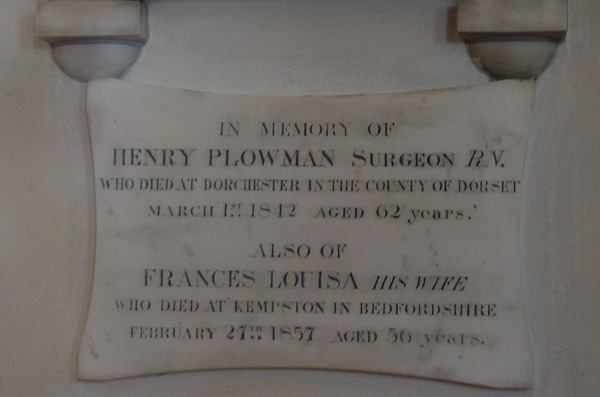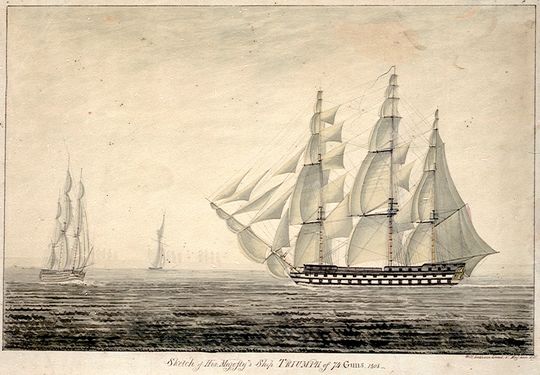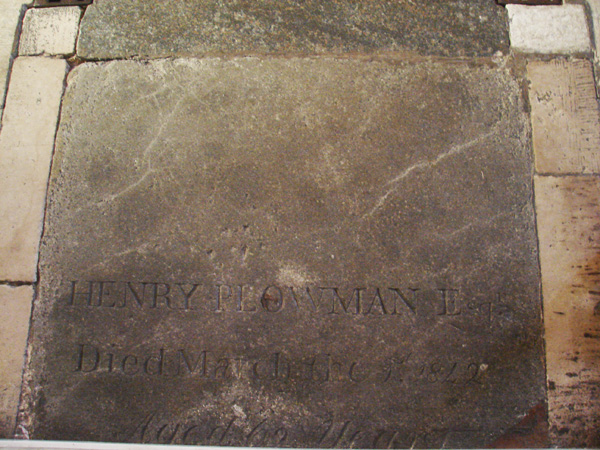(Last updated Dec 2016/Jan 2017 following new information supplied by descendant Stephen J.F.Plowman)

His Memorial in St Peter's Church Dorchester
© Picture by Michael Russell OPC for Dorchester 2012

His grandfather was the Revd: John PLOWMAN BA. (1695-1768), the son of William PLOWMAN of Winterbourne Steepleton in Dorset and a graduate of Wadham College in Oxford where he matriculated on 4 Apr 1712 at the age of 17 (1). He was awarded his BA Degree at Christchurch in 1716 and immediately joined the church being ordained a deacon at Christchurch Cathedral in Oxford on 27th May 1716. On the 8th Sept 1716 he took up an appointment as curate of St Peter and St Paul's Church in Mapowder in Dorset. He was not ordained as a priest however until 25th May 1719 (2) (also at Christchurch Cathedral in Oxford) when he was made Vicar of Tolpuddle a position he retained until his death in 1768 (3). He married Mary CHAPMAN (d.1745) also from Tolpuddle, at Blandford St Mary on 11 Feb 1723 (4) and they are reputed to have had 8 children, the last being Henry's father John Plowman shown below(5). His grandmother Mary was buried at Tolpuddle on 14th Feb 1745/6 followed by his grandfather on 25th Jan 1768. His grandfather left a will (6) which shows that he was a wealthy man with interests in many properties (particularly at Burleston) which he distributed amongst his children. His father was Rev. John PLOWMAN MA (1741-1784) and had been baptised at Tolpuddle on 28th Oct 1741. He also became a graduate of Wadham College in Oxford (1) having matriculated there on 4th April 1759 at the age of 17. He was awarded his BA degree in 1763 and MA in 1765. He was ordained a deacon at the Grosvenor Chapel in Middlesex on 18th March 1764 and the following day, nominated by his father, he was licenced as a curate to serve the cure of Tincleton in Dorset. On the 29th March 1770 he was appointed Vicar of Toller Porcorum, a position he held until his death there in 1784 (2). John married twice, firstly to Mary WARREN at Dulverton in Somersetshire on 16th July 1767. Under his marriage settlement he was to receive £1,000. He had two children by her both named John Warren Plowman, the first being born in 1768 died the same year, the second born in 1771 lived until 1799 inheriting £1,000 from his father. Mary died young, being buried at Tolpuddle on 28th June 1775. John soon re-married at Toller Porcorum on 7 Nov 1776 to a spinster named Elizabeth GOLLOP from the parish of Holy Trinity in Dorchester. They have 4 more children between 1777 and 1782, the second being Henry Plowman the subject of this biography. His father wrote a long will which he signed on 27th Jan 1784 and was proved at London on 22nd May 1784 (7a) . Henry PLOWMAN (1779-1842) was baptised at Toller Porcorum on the 17th June 1779 (1) , the 2nd son by his fathers second wife, Elizabeth nee Gollop. As far as I know his first few years were spent with his parents and siblings at Toller, but being from a wealthy family he would have attended private school from an early age. This was usually from around the age of 8 where he would have studied in preparation for university or some other form of education or apprenticeship - usually attained between the ages 14/18. The most logical place for him to have gone would have been the Free Grammar School in Dorchester, but I have not managed to locate any records which would confirm this. The next firm evidence regarding him is his career in the Royal Navy. 
He presumably received some form of medical training in his youth as he joined the Royal Navy serving initially in 1801 as Surgeon's First Mate on HMS Orion. From 1804 he went on to serve on many ships of war as a surgeon - details given below:-  Surgeons 1st Mate - 31 Mar 1801 to 10th July 1802 HMS Orion was a 74-gun third rate ship of the line of the Royal Navy, launched at Deptford on 1 June 1787. The Picture left shows a model of the Orion held at the Vancouver Maritime Museum By the time he joined HMS Orion she had already taken part in all the major actions of the French Revolutionary and Napoleonic Wars under a series of distinguished captains. On the 15th of January 1802, whilst still on board the Orion which was anchored at Spithead, Henry wrote his first will (8) in which he leaves everything to his widowed mother Elizabeth nee Gollop. This will, pictured right, is signed by Henry and witnessed by the Orion's Captain R Cuthbert and Mr Perry the Master. It was forwarded to the Admiralty under cover of a letter which stated "Enclosed I send the Will of Henry Plowman of His Majesty's Ship Orion, under my command for your inspection, and pray your forwarding a cheque accordingly. I am Sir, your most obedient Honourable Servant, Signed John Beddinfield Esq - Orion Spithead Jany 15th 1802" On 21st October 1805 after Henry had left the Orion, now under Captain Edward Codrington, she took part in the Battle of Trafalgar where, with HMS Ajax, she forced the surrender of the French 74-gun ship Intrèpide which they scuttled. HMS Prince Surgeon's 1st Mate - 13 Apr 1803 to 5 Jan 1804 HMS Prince was a 98-gun second rate ship of the line of the Royal Navy, launched on 4 July 1788 at Woolwich. She also was later present at the Battle of Trafalgar. HMS Thunder B8 (12) Surgeon - 26 Jan 1804 to 4 Sep 1805 I had some difficulty identifying this ship. There are a number of vessels that were named HMS Thunder over the years but the only one in 1804 appears to have been an 8 gun bomb vessel which the Royal Navy purchased in 1803 (originally called the 'Dasher' which they renamed HMS Thunder). If this is the correct vessel it was smaller than the previous vessels he had served on, but that might be because it was his first posting as ships surgeon (12). HMS Amphion Surgeon - 5 Sep 1805 to 30 Nov 1807 HMS Amphion was a 32-gun fifth rate frigate of the Royal Navy and was launched on 19 March 1798. Recommissioned in 1803 she later transported Horatio Nelson to the Mediterranean to take command of the fleet. After the battle of Trafalgar on 21 October 1805, Amphion was at the blockade of Cadiz. On 25 November, Thunderer detained the Ragusan ship Nemesis, which was sailing from Isle de France to Leghorn, Italy, with a cargo of spice, indigo dye, and other goods. Amphion shared the prize money with ten other British warships so Henry Plowman would have benefited as well. HMS Barfluer Surgeon - 7 Mar 1808 to 15 May 1809 (See Also 2nd appointment 6 Oct 1811 below) HMS Barfleur was a 90-gun second-rate ship of the line of the Royal Navy launched at Chatham Dockyard on 30 July 1768. In about 1780, she had another eight guns added to her quarterdeck, making her a 98-gun ship; she possessed a crew of approximately 750 and was a ship of long service and many battles. In 1808, under Capt. D. M'Cleod, she served as the flagship of Rear-Admiral Charles Tyler and was engaged in the blockade of Lisbon and also as the escort to Plymouth of the first division of the Russian squadron commanded by Vice-Admiral Dmitry Senyavin. Henry Plowman's medical journal which he completed whilst on board HMS Barfleur survives and his held at the National Archives at Kew (11). It covers the period 9 March 1808 and 8 March 1809, during which time the said ship was employed in Portsmouth Harbour, Spithead, off the River Tagus, Vigo Bay, Corunna Harbour, Cawsand Bay and off Cadiz. On the 14th January 1809 HMS Barfleur also acted as a hospital ship to receive the military wounded of the battle of Corunna. HMS Triumph Surgeon - 16 May 1809 to 10 Aug 1810  HMS Triumph (picture left out of copyright) was a 74-gun third rate ship of the line of the Royal Navy, launched on 3 March 1764 at Woolwich. Henry Plowman joined the ships company as surgeon on 16th May 1809. HMS Triumph (picture left out of copyright) was a 74-gun third rate ship of the line of the Royal Navy, launched on 3 March 1764 at Woolwich. Henry Plowman joined the ships company as surgeon on 16th May 1809. Following a hurricane on on March 4, 1810, that lasted 4 days, two British ships, HMS Triumph and HMS Phipps, salvaged a large load of elemental mercury from a wrecked Spanish vessel near Cadiz, Spain. The bladders containing the mercury soon ruptured and the mercury soon spread about the ships in liquid and vapour forms. The sailors suffered with neurological compromises: tremor, paralysis, and excessive salivation as well as tooth loss, skin problems, and pulmonary complaints. Later, in 1823, William Burnet MD published a report on the effects of Mercurial vapour. The Triumph's surgeon, Henry Plowman, had concluded that the ailments had arisen from inhaling the mercurialized atmosphere. His treatment was to order the lower deck gun ports to be opened, when it was safe to do so; sleeping on the orlop was forbidden; and no men slept in the lower deck if they were at all symptomatic. Wind sails were set to channel fresh air into the lower decks day and night.(14) HMS St Albans Surgeon - 24 Nov 1810 to 1 Oct 1811 HMS St Albans was a 64-gun third rate ship of the line of the Royal Navy, launched on 12 September 1764 at Blackwall Yard, London. She had a distinguished history having served in the American War of Independence from 1777 and been part of the fleet that captured St Lucia and won victories at Battle of St. Kitts and The Saintes. By the time Henry Plowman joined her however HMS St Albans was being used as a floating battery. HMS Barfluer Surgeon - 6 Oct 1811 to 27 Oct 1812 Henry was appointed a second time to HMS Barfleur on 6th Oct. 1811 serving until 27th Oct. 1812 with Captain Sir Thomas Masterman Hardy (1769-1839) in command. HMS Ramillies Surgeon 2 Nov 1812 to 28 Aug 1815 On 18th June 1812 President James Madison of the United States signed the declaration of War against Great Britain. In August Captain Sir T M Hardy took command of the RAMILLIES which was being sent to North America and Henry Plowman also transferred to the Ramillies arriving on station on 2nd November 1812. Hardy,led the fleet that escorted and transported the army commanded by John Coape Sherbrooke which captured significant portions of eastern coastal Maine (then part of Massachusetts), including Fort Sullivan, Eastport, Machias, Bangor, Castine. However, on 10 August 1814, a landing party from Ramillies was defeated at Stonington, Connecticut. The party was to have burned Stonington Borough and the shipping, but was repulsed. During the Battle of North Point, a composite battalion of Royal Marines , from HMS Tonnant, HMS Ramillies , HMS Albion and HMS Royal Oak were landed, under the command of Brevet Major John Robyns. The two fatalities were from HMS Ramillies. Having completed 11 years active service in 1815 HMS Ramillies became the last ship that Henry Plowman served on, before he married. He settled in the parish of St Marylebone in London and on 10 Dec 1817 married by licence to Mary Elizabeth Kirkham (1782-1820) in her home parish of Winterbourne Houghton in Dorset The likelyhood is that Mary was born in Winterbourne Houghton around the year 1782 but unfortunately parish registers have not survived. (15) . They returned to London to live at 9 Portman Street and Mary soon gave birth there to a baby girl on 11th Sep 1818,whom they named Emily Mary Plowman. She was duly baptised the following month at St Marylebone on 9th Oct (16) . Unfortunately Emily died at the age of 8 months being buried there on 27th May 1819 (17) . A year later Mary herself died when she was still only aged 38 and buried there on 17th July 1820. (18)
He was also subscribed to and was involved in setting up the Dorset County Hospital and on 16th March 1841 elected as a member of the first management committee.
(4.2) William Taunton Plowman MD, MRCS, GP (1831-1865) He was baptised at St Peters Church in Dorchester on 5th April 1832 and trained to be a doctor, initially as a student at Kings College London (28) . From there he attended St Andrews University in Scotland where he obtained his Doctor of Medicine degree. He became a member of the College of Surgeons in London and became a general practitioner in St Austell Cornwall. He married in 1859 to Catherine Ann HARDSTAFF at Taunton in Somerset by whom he had a son William Henry Monckton Plowman born at St Austell. They moved to live in Brisbane Queensland Australia but William died at sea on 20th April 1865. Administration of his estate of £600 was not granted to his widow however until 1871 by which time she had remarried to James Alexander ROUSE of North Curry Somerset. (4.3) John Herbert Plowman MA (1836-1890) He was baptised at St Peters Church in Dorchester on 24 Mar 1836 and also became a graduate of Trinity College Cambridge where he matriculated on 27th Apr 1854 at the age of 18. He was awarded his BA degree in 1864 and MA in 1866. He joined the church being ordained a deacon by the Bishop Lichfield in 1859 and as a priest the following year. Appointed curate of Lee-Brock hurst Salop 1859-61; Rector of St John's Toronto Canada 1862-5; Curate of Heytesbury Wiltshire 1866-79. Domestic Chaplain to Lord Heytesbury 1877-190. Died 28 Mar 1890.  Floorslab in St Peter's Church Dorchester © Picture by Michael Russell OPC for Dorchester 2012 Genealogical Notes:- |